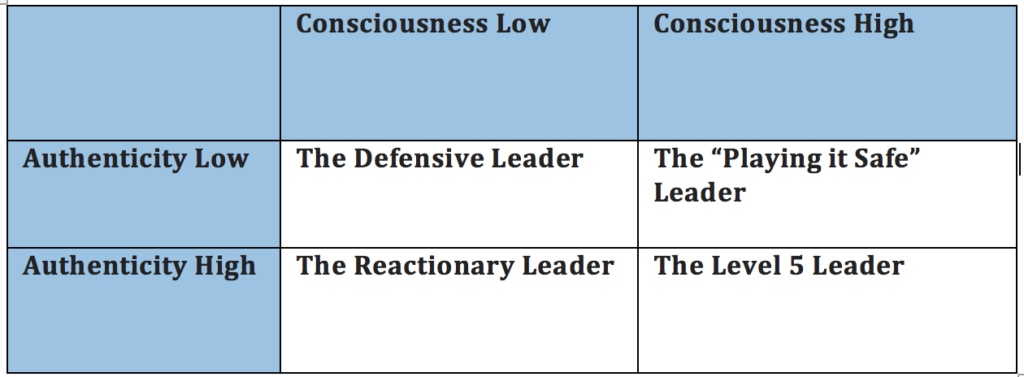How to be an authentic and conscious leader
How easy or difficult is it to be yourself — your real self? Some leaders believe leadership is “showtime,” where you put on a mask to fit a particular situation. It’s not. Others sense whether or not you are authentic, and then decide whether or not they trust you.
In his book “Authentic Leadership: Rediscovering the Secrets to Creating Lasting Value,” Bill George makes the following observations about authentic leaders:
“Others follow them because they know where they stand. They are consistent and self-disciplined. When their principles are tested, they refuse to compromise. Authentic leaders are dedicated to developing themselves because they know that becoming a leader takes a lifetime of personal growth…Authentic leaders genuinely desire to serve others through their leadership. They are more interested in empowering the people they lead to make a difference than they are in power, money, or prestige for themselves. They are as guided by qualities of the heart, by passion and compassion, as they are by qualities of the mind.”
In the many years since George wrote his book, I believe authentic and conscious leadership have become confused. Authenticity is finding and being your real self. Consciousness is being aware of and managing your personality (instead of it managing you). If you want to be truly authentic, you must also be conscious.
Four types of leaders
Let’s use this grid to explore the interaction of authenticity and consciousness:

1) The Defensive Leader
A defensive leader entrenches himself in a small comfort zone. He hasn’t developed the capacity to search inside and be honest with himself. When confronted with a threat, he blames others or circumstances. He vigorously defends his position because his unmanaged ego demands that he be right.
I often hear the argument that “jerks” say everything on their mind and are authentic (I’m not naming names here, but politics is full of examples!). If you assume that their unexplored egos are the same as their real selves, then there is some truth in that statement. But Defensive Leaders (sometimes jerks) are not conscious and have zero interest in self-exploration.
2) The Reactionary Leader
A reactionary leader also needs to stay in his comfort zone. He is aware of some of his personality patterns, and believes that they are his real self. He has not mastered self-regulation and reacts to any external stimuli. His undisciplined personality controls him.
3) The “Playing It Safe” Leader
The leader that plays it safe avoids authenticity. Instead, he focuses on fitting in, because he has not developed enough conviction and strength to go against the crowd. He makes a conscious choice to wear a mask.
4) The Level 5 Leader
Jim Collins, author of the best-selling book “Good to Great,” labeled the highest level of leaders Level 5 leaders. These leaders possess both personal humility and an iron-clad professional will.
While Collins sees this combination as paradoxical, I don’t. It is a natural result of hard inner work and a high level of consciousness. Leading from a place of security and confidence, a Level 5 leader’s ego doesn’t need to be fed. He focuses on and cares for others. He welcomes opposing opinions. His strong personal will transcends his professional life, and he never compromises his personal values.
“Good-to-great transformations don’t happen without Level 5 leaders at the helm,” said Collins. “They just don’t.”
How to become authentic and conscious
To be a Level 5 leader, both authentic and conscious, you need to:
1. Do your inner work
Inner work starts with knowing yourself: your motivation, strengths, weaknesses, personal values and purpose (these are your inner guidance). This sounds easy, but, it is not. Clarifying and understanding who you are is a lifelong endeavor and requires conscious effort, discipline and an unwavering commitment to self-development. It takes courage to persistently explore and confront the parts of yourself that you want to avoid.
2. Develop self-awareness
It’s the cornerstone of authenticity. Daniel Goleman, an internationally known psychologist and author, said:
“When I was conducting research for my book “Working with Emotional Intelligence,” I had access to about 200 competency models that companies use to identify star performers. These are all proprietary since they provide each organization with a competitive edge, but I was able to identify common themes. For example, emotional self-awareness is a leadership competency that shows up in model after model. These are the leaders attuned to their inner signals, recognizing how their feelings affect them and their job performance.
Goleman defines self-awareness as “knowing one’s internal states, preference, resources and intuitions.” To be authentic and conscious, you must recognize personality patterns or triggers as they appear and know how to relax them.
3. Make a conscious choice
After pausing and inquiring, decide how to behave and feel. Is your habitual pattern the best choice for this circumstance? Or is another behavior more helpful now? What emotion supports you? Level 5 leaders recognize, own and shift their emotions as needed.
Becoming an authentic and conscious leader is difficult and doesn’t happen overnight. You can do it if you are vulnerable and dedicate your life to self-exploration and self-growth. Why not start now? The revelatory journey will make you a wiser person and better leader.
Category: Leadership

